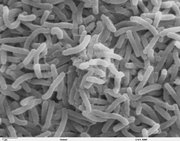Cholera
Cholera (also called Asiatic cholera) is an infectious disease, caused by bacteria that are typically ingested by drinking water that is contaminated by improper sanitation, or by eating improperly cooked fish, especially shellfish. Symptoms include explosive diarrhea, abdominal cramps, nausea, vomiting, and dehydration. Death is generally due to the dehydration caused by the illness. When cholera is left untreated, it generally has a high death rate. Treatment typically consists of aggressive rehydration. With treatment, death rates plummet. Cholera was first described in a scientific manner by the Portuguese physician Garcia de Orta in the 16th century. more...
Pathology
Susceptibility
Cholera produces potentially lethal secretory diarrhea through a pathway that involves the cystic fibrosis transmembrane conductance regulator, CFTR (Gabriel 1994). This discovery led to the hypothesis that carriers for cystic fibrosis, who have lower levels of functional CFTR, are protected from the severe effects of cholera because they don't lose water as quickly as other people. This might explain the high incidence of cystic fibrosis among populations which were formerly exposed to cholera. However, no evidence of resistance in vivo has been observed in humans, and studies in mice have produced conflicting results (Gabriel 1994, Cuthbert 1995, Hogenauer 2000).
Recent genetic research has determined that a person's susceptibility to cholera (and other diarrheas) is affected by their blood type. Those with type O blood are the most susceptible. Those with type AB are the most resistant, virtually immune. Between these two extremes are the A and B blood types, with type A being more resistant than type B.
About one million Vibrio cholerae bacteria must be ingested to cause cholera in normally healthy adults, although increased susceptibility may be observed in those with a weakened immune system, individuals with decreased gastric acidity (as from the use of antacids), or those who are malnourished.
Transmission
Cholera is transmitted through ingestion of feces contaminated with the bacterium. The contamination usually occurs when untreated sewage is released into waterways, affecting the water supply, any foods washed in the water, and shellfish living in the affected waterway — it is rarely spread directly from person to person. The resulting diarrhea allows the bacterium to spread to other people under unsanitary conditions.
Symptoms
More information at Vibrio cholerae
Symptoms include those of general GI tract upset: profuse diarrhea (eg 1L/hour), abdominal cramps, fever, nausea and vomiting. Also those of the resulting dehydration: thirst, muscle cramps, weakness, loss of tissue turgor, sunken eyes and wrinkled skin, severe metabolic acidosis with potassium depletion, anuria, circulatory collapse and cyanosis. Death is through circulatory volume shock, and can occur within hours.
The root causes of these symptoms are the enterotoxins that V. cholerae produces. The main enterotoxin, known as cholera toxin, interacts with G proteins and cyclic AMP in the intestinal lining to open ion channels. As ions flow into the intestinal lumen, water follows from osmotic pressure.
History
Origin and Spread
Cholera was originally endemic to the Indian subcontinent, with the Ganges River likely serving as a contamination reservoir. It spread by trade routes (land and sea) to Russia, then to Western Europe, and from Europe to North America. It is now no longer considered an issue in Europe and North America, due to filtering and chlorination of the water supply.
Read more at Wikipedia.org



